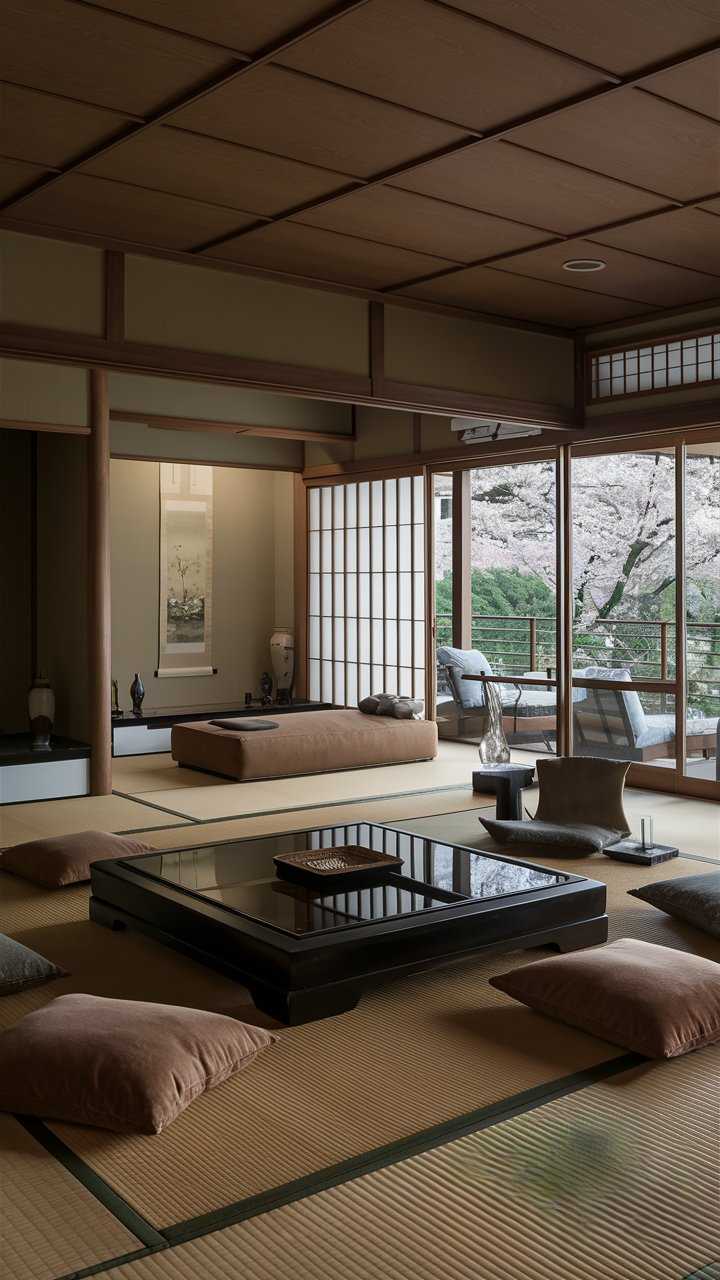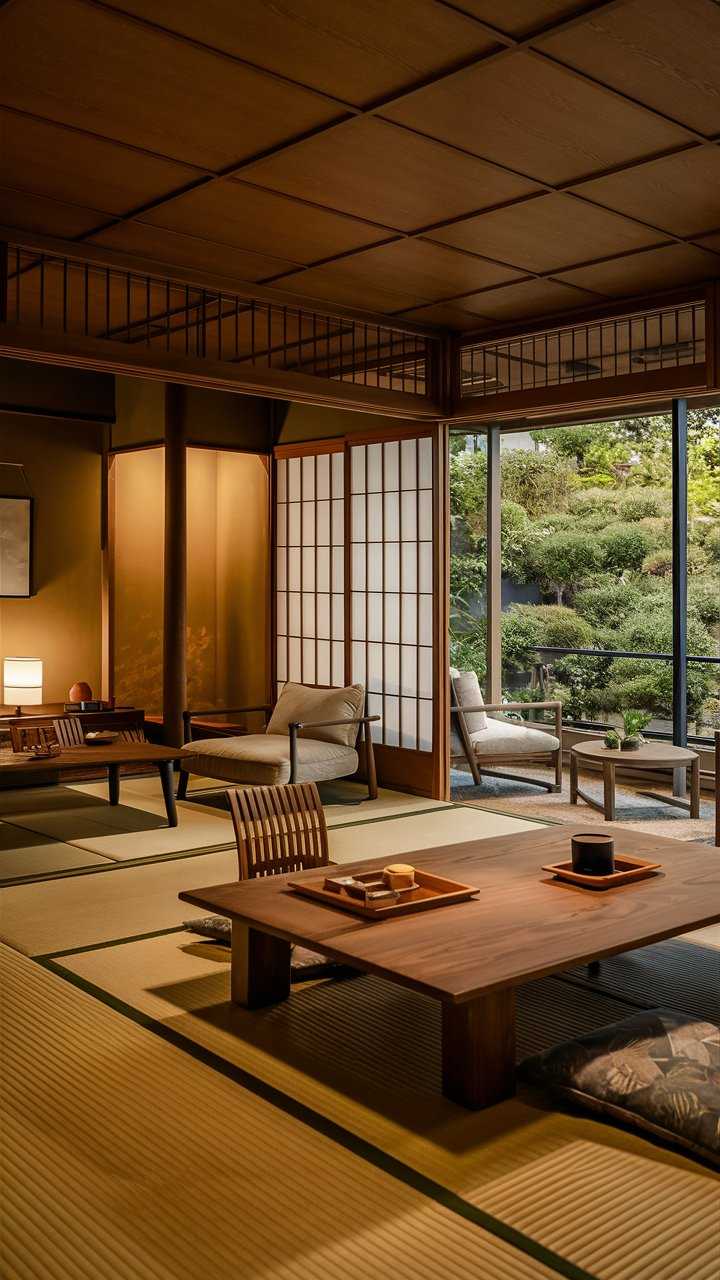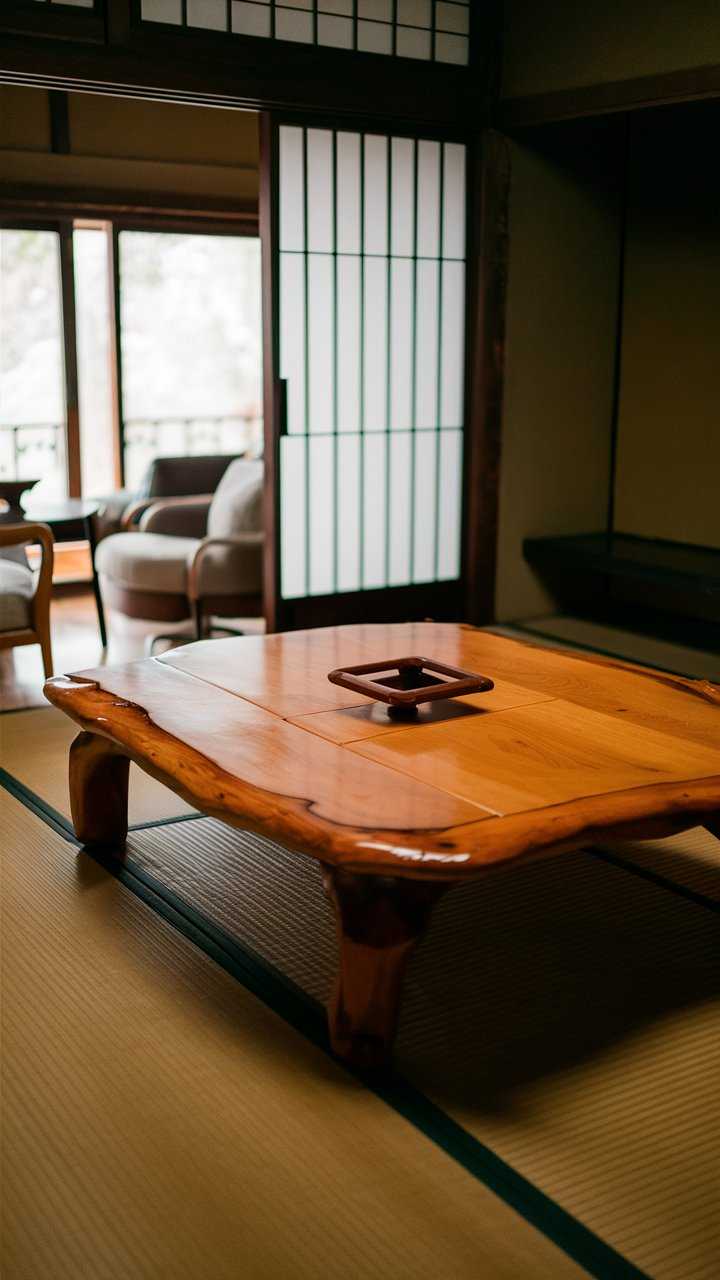Modern Japanese Living Room: Zen-Inspired Designs
A modern Japanese living room is a place of peace and simplicity. It blends traditional Japanese beauty with modern touches. This creates calm spaces that help you relax and be mindful.
Using natural materials and soft colors, it shows off Japanese design. Getting rid of clutter and adding nature makes your home feel special. It follows wabi-sabi, which values imperfections and the fleeting nature of things.
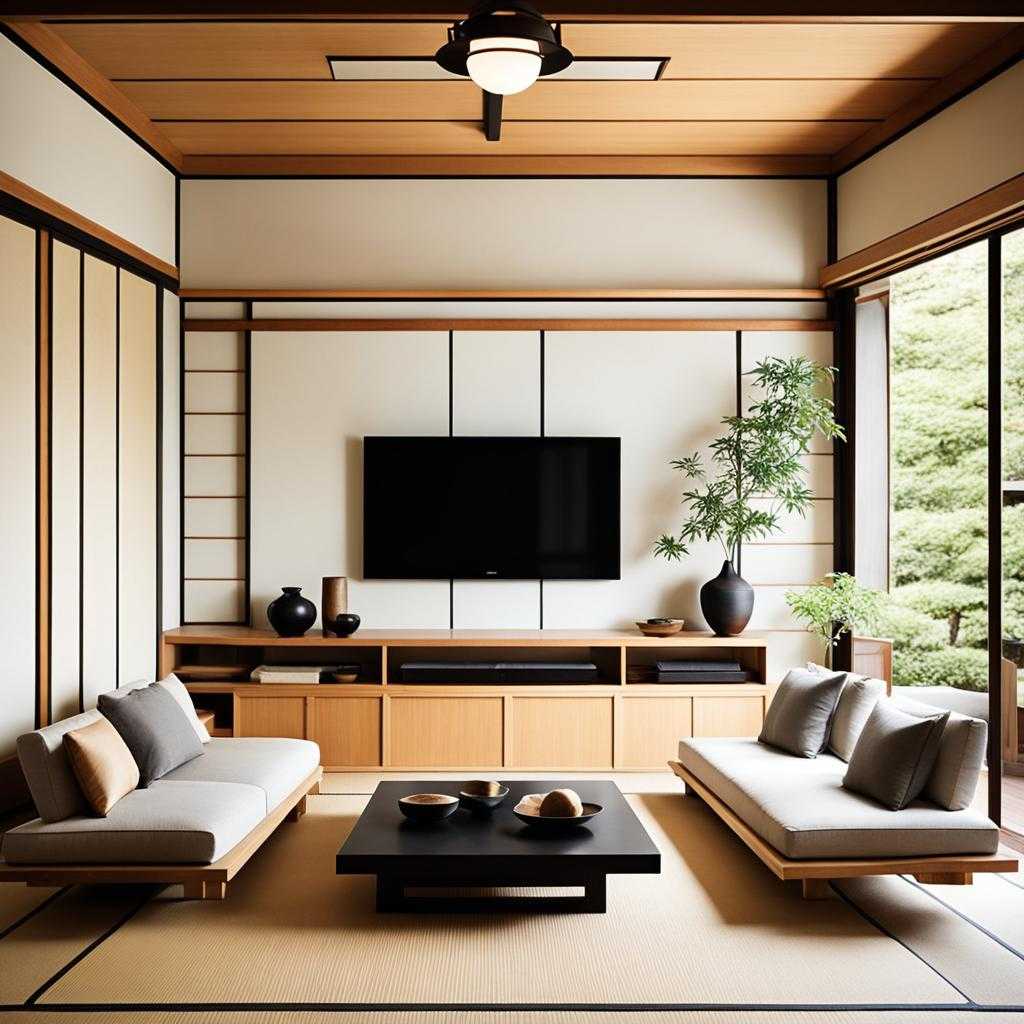
Key Takeaways
- A modern Japanese living room emphasizes tranquility and simplicity.
- Zen-inspired designs focus on creating serene living spaces.
- Natural materials and neutral colors play a crucial role in Japanese interior design.
- Decluttering enhances the overall peace of your space.
- Wabi-sabi principles celebrate the beauty of imperfection.
Understanding Zen-Inspired Design Principles
Zen-inspired design comes from Ancient Japanese aesthetics. It connects us to nature and values simplicity. The idea is to create spaces that are peaceful and show the beauty of imperfection and natural materials. Wabi-sabi is key in this design, celebrating the unique and imperfect.
Designing with mindfulness means every piece has a purpose. It helps create a calm space with less clutter. This makes it easier to move between inside and outside, promoting relaxation and thought.
Zen design brings peace into your space. It uses natural light and plants to make a welcoming feel. When furniture and decor follow these principles, you get a space that supports well-being and calm.
| Principles of Zen | Description |
|---|---|
| Wabi-Sabi | Embracing imperfection in design, allowing for beauty in flaws. |
| Mindfulness | Focusing on each element, ensuring it serves a purpose in creating harmony. |
| Simplicity | Eliminating clutter to cultivate a peaceful and serene space. |
| Connection to Nature | Integrating natural elements that enhance tranquility and relaxation. |
Key Elements of Japanese Interior Design
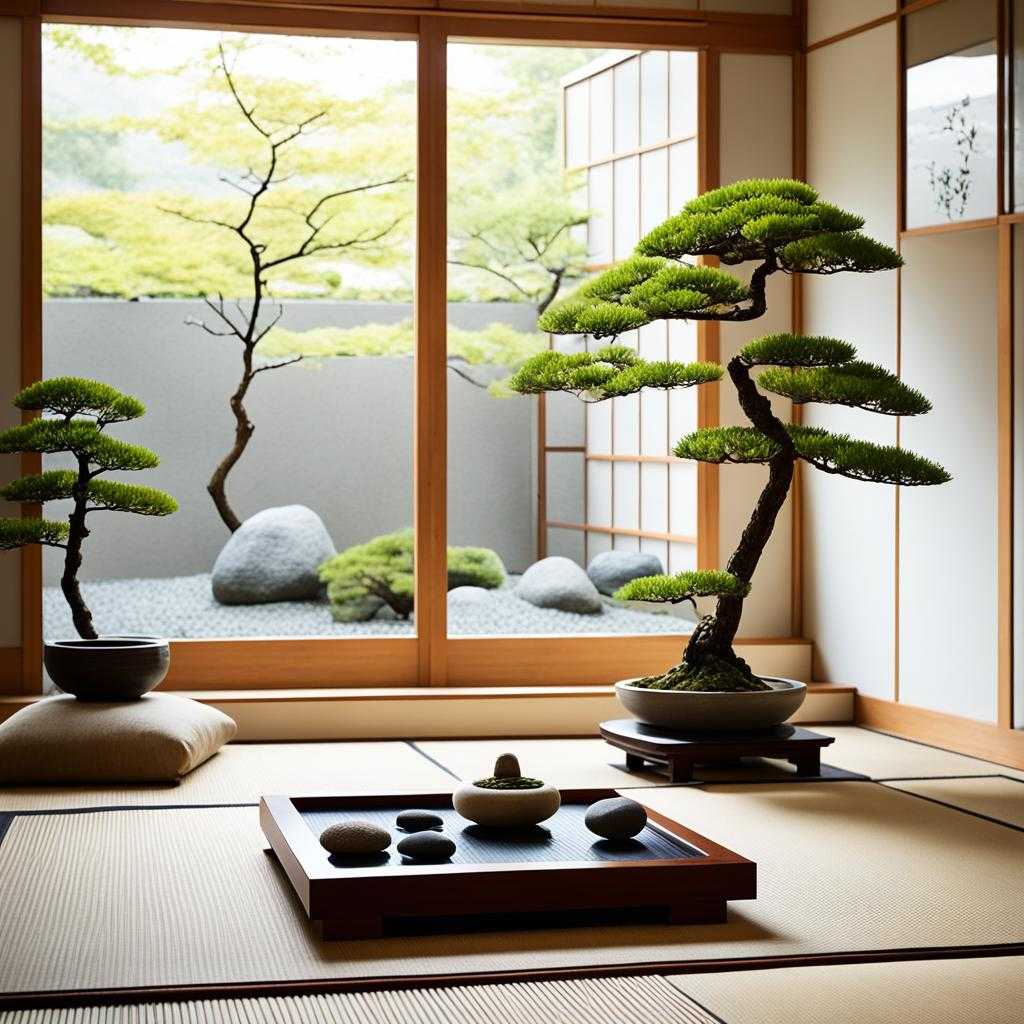
Japanese interior design is all about minimalism and natural harmony. It focuses on a clean, clutter-free look. This makes spaces perfect for relaxation and calm. Key elements include:
- Natural Materials: Wood, bamboo, and stone connect us to nature. They add warmth and character to spaces.
- Neutral Color Palette: Soft colors like beige, white, and muted greens create serenity. They make spaces feel peaceful.
- Traditional Elements: Tatami mats and shoji screens bring authenticity to modern spaces. They add depth and character.
- Open Spaces: A layout with few barriers encourages easy movement. It makes spaces feel open and minimal.
These elements work together to make spaces inviting and peaceful. Using them thoughtfully improves both the look and function of a space.
| Element | Description | Impact on Space |
|---|---|---|
| Natural Materials | Use of wood, bamboo, stone | Creates warmth and connection to nature |
| Neutral Color Palette | Soft tones like beige, white, greens | Enhances serenity and peacefulness |
| Traditional Elements | Tatami mats, shoji screens | Adds authenticity and depth |
| Open Spaces | Layouts with minimal barriers | Promotes fluid movement and openness |
Creating a Serene Atmosphere with Neutral Colors
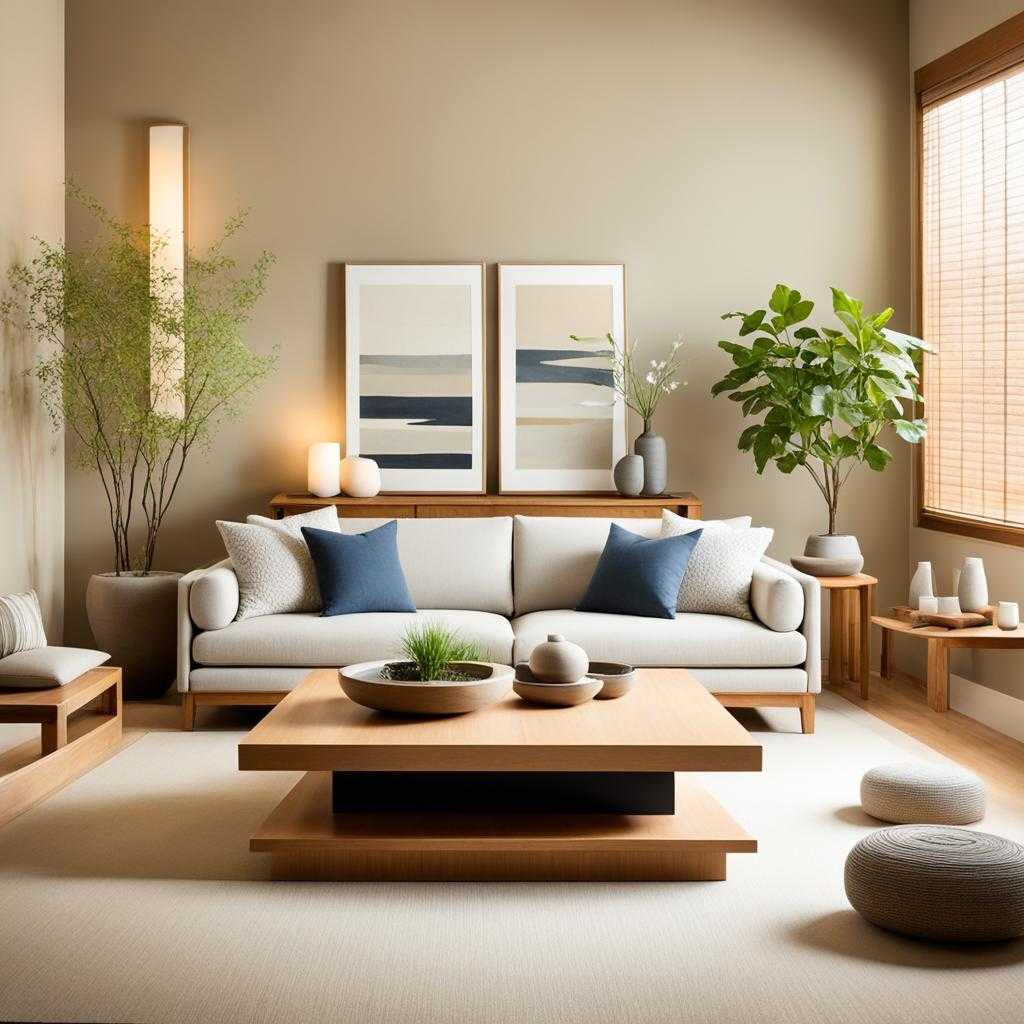
In a modern Japanese living room, the choice of color is key to creating a serene atmosphere. Using neutral colors like whites, grays, and earthy tones helps make a calming design. These colors bring a sense of peace and harmony, perfect for relaxing spaces.
Color greatly affects our mood. Soft whites and grays set a calm background, reducing distractions. Earthy tones add warmth without being too much. These colors work together to create a peaceful space, much like traditional Japanese homes.
- Choose light neutral shades for walls to enhance natural light.
- Opt for furniture in muted tones to maintain a cohesive look.
- Incorporate soft textures through textiles such as cushions and throws in neutral shades.
Neutral colors do more than just look good. They help create a calm and welcoming space. When picking colors, make sure they fit with your overall decor. This way, you can express yourself while keeping the peaceful feel of a Japanese living room.
| Color | Effect | Recommended Use |
|---|---|---|
| Soft White | Brightens space | Walls & ceilings |
| Light Gray | Creates balance | Furniture & accents |
| Earthy Beige | Adds warmth | Textiles & decor items |
Using these ideas can make your Japanese living room a peaceful retreat.
Incorporating Natural Materials into Your Space
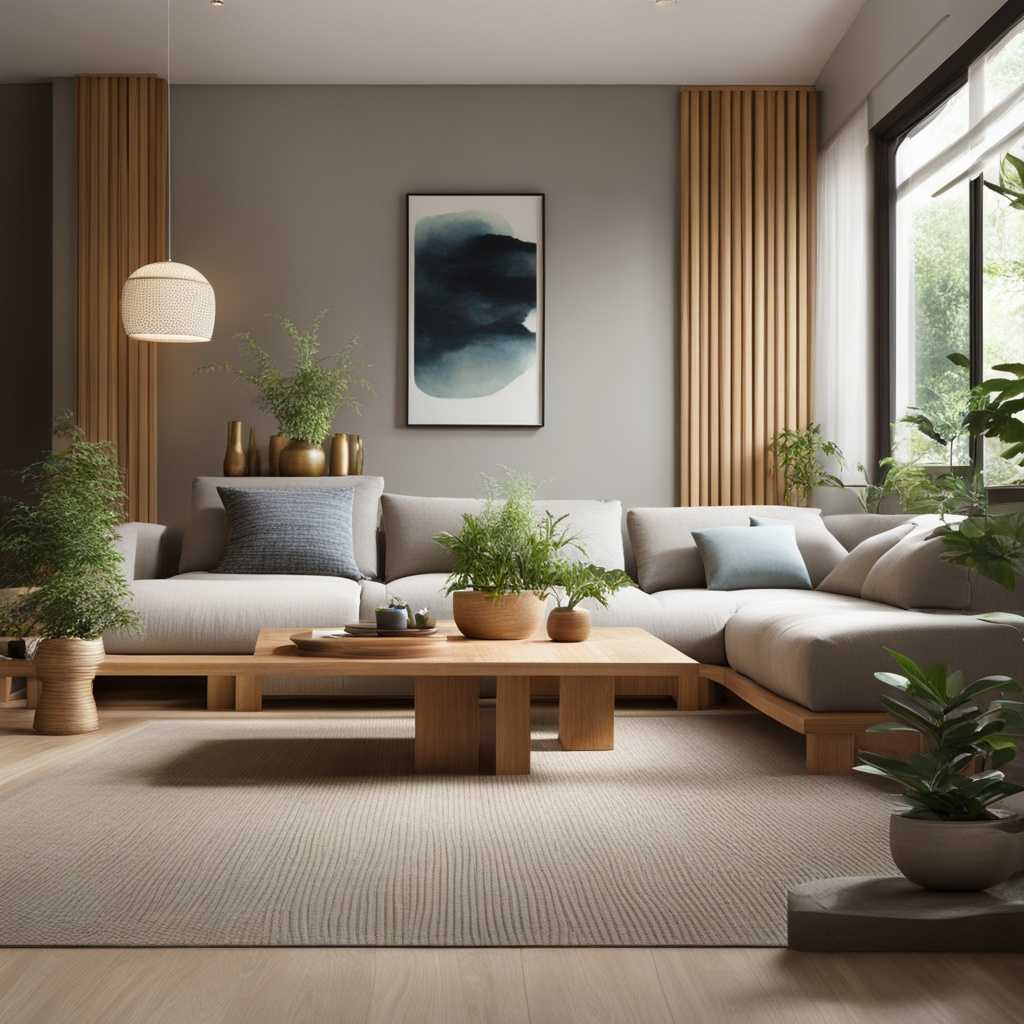
Using natural materials is key to making a Japanese living room inviting. Wood, bamboo, and stone add beauty and calm. They bring a sense of nature, which is central to Zen design.
Wooden accents bring warmth to a room. Choose finely crafted wooden furniture for both looks and function. A low table or simple bookshelf can make a space feel cozy and inviting.
Bamboo is great for adding texture and is ideal for window treatments. Bamboo blinds or screens let in light while bringing an organic feel. It’s easy to fit into many designs.
Stone accents help ground a space. Think about adding a stone vase or a patterned stone rug. These pieces add to the natural look and support sustainability.
| Material | Benefits | Recommended Uses |
|---|---|---|
| Wood | Warmth, durability | Furniture, flooring |
| Bamboo | Eco-friendly, versatile | Blinds, accessories |
| Stone | Natural elegance, grounding | Decorative items, tabletops |
Adding these natural materials makes for a peaceful living area. Choosing sustainable options creates a calm space. It looks great and shows you care about the planet.
Choosing Low Furniture for Comfort and Aesthetics
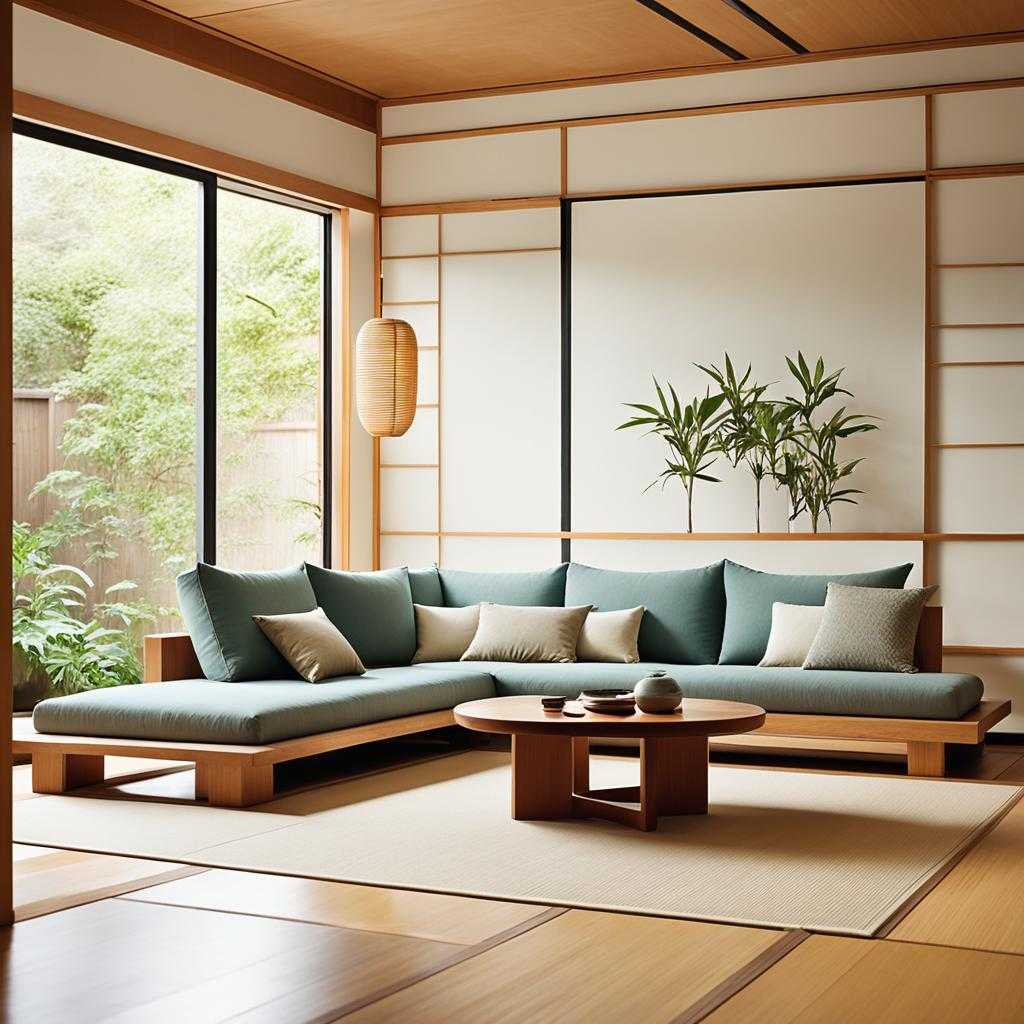
Low furniture is key to Japanese aesthetics. It combines comfort and style in modern homes. Floor cushions, meditation chairs, and low sofas bring together relaxation and function. These items help you sit naturally, creating a peaceful vibe that matches traditional Japanese ways.
Low furniture also makes the most of space optimization. It uses the floor, making rooms feel bigger. This design lets you move easily and adds flexibility to your living space. Unlike bulky furniture, low pieces fit well in small rooms, adding to the simplicity of Japanese design.
- Enhanced comfort leads to inviting spaces.
- Promotes a connection with the ground, a valued aspect in Japanese culture.
- Helps maintain an open atmosphere, essential for harmony in the home.
When picking furniture, think about both comfort and looks. Choose soft textures and supportive designs to improve your space’s feel. Adding low furniture makes your home feel more welcoming, just like Japanese hospitality, making your space more enjoyable.
Utilizing Shoji Screens for Flexibility and Style
Shoji screens are key to Japanese design, offering both function and beauty in modern homes. They work as room dividers, making it easy to change the layout of small spaces.
Using shoji screens gives you privacy and lets in lots of natural light. This creates a perfect mix of openness and privacy. It shows the beauty of Japanese design, which values nature. With shoji screens, you can make different areas in a room that still look connected.
Shoji screens also bring art to your home. Their detailed patterns and materials follow the simple beauty of Japanese style. Here are some reasons to use shoji screens:
- Versatile room divisions: Make more areas in one space.
- Light diffusion: Soft light filters through, making the space warmer.
- Customizable designs: Pick from many styles and finishes to match your taste.
Adding shoji screens shows you know how beauty and usefulness can go together. These designs capture the spirit of Japanese style, making it easy to move between different activities at home. For more on creating timeless interiors, check out this resource on mid-century modern design. It shares ideas that work well with shoji screens.
Smart Storage Solutions in a Japanese Living Room Modern
Smart storage solutions are key to keeping a modern Japanese living room tidy. They help free up space and keep the room calm and clear. The right way to organize things makes the room both useful and peaceful.
Using multifunctional furniture is a smart move. For instance, ottomans with hidden spots or coffee tables with storage keep things neat and useful. This way, important items are easy to get to but stay out of sight, keeping the room looking clean.
- Install shelves that use vertical space and show off your decor while storing things.
- Opt for furniture that does more than one job, like sofa beds or tables that expand.
- Use baskets or boxes to keep small items together, making them easy to find without cluttering the room.
Adding smart storage to a modern Japanese living room brings a perfect mix of style and function. It makes the space look calm and work well, showing off the beauty of Japanese design.
Decorative Touches: Ikebana Arrangements and Wooden Accents
In a Japanese living room, decorative touches make a big difference. Ikebana arrangements are a key feature, adding life and color. This traditional flower arrangement is all about simplicity and beauty. It creates a peaceful spot for reflection.
Wooden accents are crucial for the Japanese decor look. Using handcrafted sculptures, bowls, and small furniture from natural wood connects us to nature. These items add warmth and depth to the room with their unique textures and tones.
By mixing ikebana arrangements and wooden accents, you can make a space that shows off your style and cultural roots. This mix creates a peaceful atmosphere that’s typical of Japanese design.
| Decorative Element | Purpose | Example |
|---|---|---|
| Ikebana Arrangements | Brings life and color | Simple floral centerpiece |
| Wooden Accents | Add warmth and texture | Handcrafted wooden bowl |
| Natural Materials | Connects with nature | Teak wood furniture |
| Color Palette | Enhances tranquility | Earth tones |
Creating Balance with Minimalist Furniture
Achieving balance in a living room is key to Japanese design. It’s all about using minimalist furniture. This kind of furniture helps keep the space clean and useful without taking up too much room.
When picking furniture, look for pieces that are simple yet elegant. The right setup makes the room flow well and look good. Using low furniture, like futons or low chairs, connects you to the floor. This is a big part of Japanese design.
Focus on furniture that is functional yet simple. This creates a calm space perfect for relaxing and being mindful. Here’s a look at different types of minimalist furniture and what they offer.
| Furniture Type | Key Features | Benefits |
|---|---|---|
| Futons | Compact, versatile | Easy to store and allows for spaciousness |
| Low Tables | Sleek design, natural materials | Promotes a casual, inviting atmosphere |
| Minimalist Chairs | Streamlined forms, ergonomic | Provides comfort without excess bulk |
Conclusion
Creating a modern Japanese living room means focusing on making peaceful spaces. Key elements like neutral colors, natural materials, and low-profile furniture are crucial. They help create a sense of calm and stability.
By combining these elements thoughtfully, you can make a space that’s both a living area and a personal sanctuary. This approach helps you develop an environment that supports your well-being.
As your home becomes a serene retreat, it connects you more with nature. It also promotes a lifestyle focused on mindfulness. This design encourages simplicity, leading to a clutter-free space that boosts mental clarity and relaxation.
Choosing each piece with care results in a space that perfectly balances functionality and beauty. This makes your living room a true reflection of the zen spirit. It becomes a peaceful place where every detail adds to the calm atmosphere, enriching your life.


